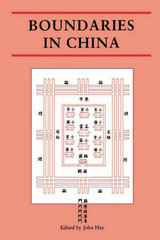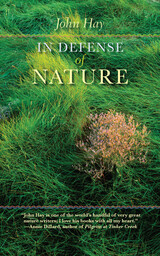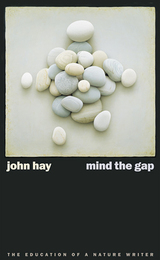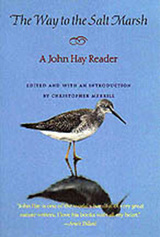4 books by Hay, John

Boundaries in China
John Hay
Reaktion Books, 1994
A crucial topic in the study of Chinese culture past or present is that of the "boundary". In this book the authors investigate the meaning of the boundary as metaphor and paradox, as threshold and interface across the whole spectrum of Chinese art and society. The essays range from early politics and society to contemporary public and private discourse; from the creation of a literary canon to the positioning of individuals in dynastic time; from the public spaces in today's Peking Opera to the intangible surfaces of self in 14th-century painting.
All the authors in this book are established Sinologists. Boundaries in China will be stimulating reading for anyone interested in the psycho-social dynamics of non-Western art and culture.
Includes essays by Robin D. S. Yates, Wu Hung, Pauline Yu, John Hay, Jonathan Hay, Dorothy Ko, Isabelle Duchesne, Rey Chow, Ann Anagnost.
All the authors in this book are established Sinologists. Boundaries in China will be stimulating reading for anyone interested in the psycho-social dynamics of non-Western art and culture.
Includes essays by Robin D. S. Yates, Wu Hung, Pauline Yu, John Hay, Jonathan Hay, Dorothy Ko, Isabelle Duchesne, Rey Chow, Ann Anagnost.
[more]

In Defense of Nature
John Hay
University of Iowa Press, 1969
Frequently compared to Edward Abbey, Wendell Berry, and Gary Snyder, John Hay is one of this country’s greatest nature writers. Originally published in 1969, In Defense of Nature is an eloquent and prescient plea on behalf of the natural world. Devoid of sentimentality yet lyrical and deeply moving in its portrayals of our despoliation of nature, Hay’s classic work is now available to a new generation of readers.
Wendell Berry has called John Hay a “carrier of light and wisdom.” In Defense of Nature reveals why this is true. In it Hay has written an extended meditation on the environment and our place in it. Its lessons never more important, In Defense of Nature eerily presages the tenuous state of our environment and our place in it. As our technical abilities have moved forward, our judgment has not kept pace. “What we call natural resources cannot be limited to gas, oil, pulpwood, or uranium,we are starving the natural resources in ourselves. The soul needs to stretch; being needs to exercise.”
[more]

Mind The Gap
The Education Of A Nature Writer
John Hay
University of Nevada Press, 2006
John Hay has been acclaimed as one of the most significant contemporary nature writers and environmentalists. In Mind the Gap, an autobiographic memoir and a passionate commentary on our place in the natural world, he retraces the paths that led to his career and explores the literary and environmental influences that shaped his interest in nature. Born into a respected old New York family, Hay grew up in upper-class Manhattan and rural New Hampshire, between the rigid proprieties of society and the delicious freedoms he discovered during his outdoor adventures. Travel, education, and his own sensitivity and curiosity helped to open the world to him. Shortly after World War II, he moved to a desolate, sandy lot on Cape Cod. Much of the book deals with his life in a small rural community on the Cape, addressing such subjects as the annual herring spawn, resident and migratory birds, local wildlife, his human neighbors, and the complex rhythms of life in this region of wind and sea. Hay’s closely observed descriptions of his surroundings support his insightful comments on nature and our relationship to it. He warns us that “in setting ourselves apart from the rest of living creatures, we fall victim to our own ice-bound conceit. It is only in sharing that we know anything at all.” Hay shares his knowledge generously, and as readers we are thereby enriched. Available in Hardcover and Paperback.
[more]

The Way to the Salt Marsh
A John Hay Reader
John Hay
Brandeis University Press, 1998
"In common things are greater extensions of ourselves than we ever conceived of." "Life on earth springs from a collateral magic that we rarely consult," observes John Hay, naturalist, essayist, sage, and inveterate walker of byways. This collection from the 50-year long career of America's preeminent nature writer illustrates the full range of Hay's work. An elegant and lyrical stylist, he is, in Merrill's words, "the nature writer's writer, an illustrator of the Emersonian notion that 'the world is emblematic.'" And so Hay reveals the ubiquitous but often unnoticed emblems all around us. The mad, impossible rush of alewives flinging themselves upstream to mate, for example, represents "the drive to be, a common and terrible sending out, to which men are also bound in helplessness." In the migratory movements of the terns and the green turtles past his beloved Cape Cod Hay sees the mystery and magnificence of homing: "To know your direction and return through outer signs, is as new as it is ancient. We are still people of the planet, with all its original directions waiting in our being." Whether describing the rugosa or bayberry of a sand dune, the plight of stranded pilot whales, or a spider swinging on its gossamer, Hay encourages us to enlarge our inner universe by observing, appreciating, and preserving the outer one we so often ignore. As a result, he says, "we may find that we are being led onto traveled ways that were once invisible to us," and by recognizing our "deep alliance with natural forces we find a new depth in ourselves. This is the common ground for all living things."
[more]
READERS
Browse our collection.
PUBLISHERS
See BiblioVault's publisher services.
STUDENT SERVICES
Files for college accessibility offices.
UChicago Accessibility Resources
home | accessibility | search | about | contact us
BiblioVault ® 2001 - 2024
The University of Chicago Press









